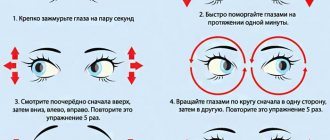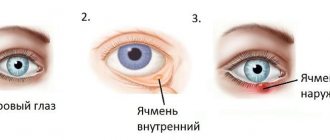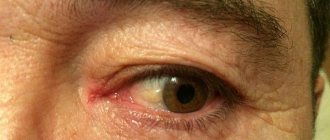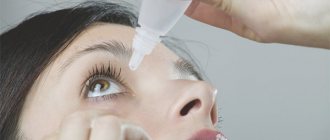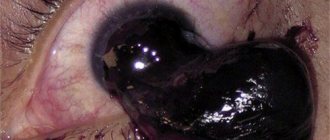They will talk about the reasons why people cannot open their eyes. Doctors take this problem seriously. Drooping eyelids are always a worrying sign. Drooping of the upper eyelid - ptosis - is a symptom of the disease. Myasthenia gravis
may be the cause of drooping eyelids.
This disease is characterized by a condition of the immune system
, which begins to harm nerve impulses.
This disease results in muscle weakness.
Muscles lose the ability to contract normally.
Nerve impulses cannot transmit a signal
from one nerve to another.
There are also signs of myasthenia gravis
, this is double vision and strabismus.
This disease is dangerous. A person may stop breathing
due to muscle weakness. This condition needs to be treated.
Another cause of ptosis may be Horner's syndrome.
It is characterized by drooping of one eyelid, a narrow pupil and
the absence of tears in the eye
. The body has a system of wakefulness and sleep.
It happens that the tumor is in the apex of the lung
we compress the nerves that go to the eyeball,
the parasympathetic system
. We are talking about cancer of the apex of the lung. The tumor must be removed.
The cause of drooping eyelid may be conjunctivitis with swelling of the eyelids.
Infection can lead to swelling,
and allergies can also lead to swelling.
It may also be unpleasant for a person to look at the light; he closes his eyes.
This disease is treatable.
can form
on the eyelids Such wen often appears in older people.
We are talking about high cholesterol levels.
The carrier of fat is cholesterol.
If cholesterol levels are elevated, fatty deposits begin to appear. Sometimes this is a hereditary increase in cholesterol
that is not associated with obesity.
High cholesterol levels are dangerous for blood vessels.
Cracks appear in the vessels, fat becomes clogged in them, plaques appear, and then
there may be a blood clot and a stroke
or heart attack. Atherosclerosis leads to narrowing of blood vessels.
If one eyelid does not lift, this may indicate a serious illness
.
One of the manifestations of this disease is one eye that is slightly closed. Ptosis may be accompanied by constriction of the pupil and retraction of the eyeball
.
These symptoms are characteristic of a number of neurological diseases.
But today we will talk
about a tumor in the upper part of the lung,
which is connected to the neck by nerves. A spasm of the muscles that open the eyelids may occur.
It seems that the person is squinting very hard and cannot open his eyes.
If the conduction system is disrupted, for example, with multiple sclerosis.
The immune system attacks its organs
in this disease.
The immune system attacks the nerve sheaths, the nerves cannot conduct impulses, and a spasm occurs.
The eyes may become sticky due to the discharge of pus. This is conjunctivitis. The eyeball is covered by a membrane, it is white or blue, this is the protection of the eye. The conjunctiva is washed with tears.
There should be no visible vessels in it.
If there is inflammation, the eye turns red. Bacteria or viruses enter the eye. There is a burning sensation, lacrimation, and photophobia. The eye may stick together
in the morning, and pus may ooze from the eye.
At night, you can put antibiotic ointment behind your eyelids.
If the inflammation is very acute, you can even give a hormonal drug.
There are antihistamines if you have allergies. If inflammation is caused by a virus
, then there are interferon solutions. You should not instill tea infusion. It's useless.
For conjunctivitis, drops are used,
but they need to be dripped correctly, they must linger in the cavity for them to act.
You need to raise your head, pull back the lower eyelid,
apply drops,
hold the eyelid for a while
.
For bacterial conjunctivitis, antibiotic drops are used.
For viral conjunctivitis
antiviral drugs and interferon-based drugs are used
for immunity
.
a bacterial infection
is often concomitant . Therefore, it is necessary to use antibacterial drops.
For allergic conjunctivitis
you need to
exclude the allergen,
do not use mascara that caused the allergy.
At home, you need to follow the rules of hygiene
if someone is suffering from viral conjunctivitis.
Wash your hands
and use antibacterial hand gels.
Eyes may turn red when a foreign body enters the eye. Is it a chemical effect or physical. Corneal erosion may occur
. A laser pointer or beam can damage your eyes. Doctors can see such damage during examination. The doctor will put drops in the eye and see the erosion.
The pain is severe with a corneal ulcer. Tears flow, the person cannot open his eyes. If something gets in, you need to remove it with a cotton swab or rinse with water.
If you try to remove the foreign body with something, you may scratch the eye further.
The choroid of the eye may suffer. In this case, the eyes are red. Uveitis is a serious condition that can make you blind. The iris is supplied with blood. The vascular network envelops the eyeball from the inside. If a virus, including the herpes virus
gets inside.
The choroid of the eye becomes inflamed. Vision becomes blurred. 25% of blindness in the world is due to uveitis.
It is important to quickly consult a doctor and treat the disease. There is no need to mindlessly drop eye redness drops. If you don't identify the causes of red eyes, you risk going blind. A person may have blepharospasm. It all starts with one eye, and then can move to the second. Attacks can increase in duration and are often a sign of multiple sclerosis. The brain cannot work due to cholesterol plaques. It is important to do an MRI of the brain.
anonymously
Hello. I am 55 years old. Sometimes it happens to me that I look at a person and see the right side of their face, but not the left. I thought the pressure was dropping at this moment, but when I measured the pressure it was normal. After 30 minutes it goes away. When I start to get nervous about something or under mental stress, as they say, “my brain is boiling,” this is what happens to me, as if there is boiling water in my head. After a short while, it goes away. There is also a time when the jaw slams shut, as if it is uncontrollable. I also open my eyes in the morning with my hands, don’t think it’s from pus, no, they’re clean, they just don’t open and that’s it. And during night sleep my hands go numb. Please answer: is it related to blood vessels or nerves? What needs to be treated and by which doctor? Perhaps also sore knees, feet and convulsive stretching of the calves are also associated with all this?
Consultation with a neurologist on the topic “Eyes do not open in the morning” is given for informational purposes only. Based on the results of the consultation received, please consult a doctor, including to identify possible contraindications.
About the consultant
Details
Neurologist, Candidate of Medical Sciences, medical experience: 17 years. Author of more than 50 publications and scientific papers, active participant in conferences, seminars and congresses of neurologists in Russia.
Area of professional interests: -diagnosis, treatment and prevention of neurological diseases (vegetative-vascular dystonia, discirculatory encephalopathy, consequences of strokes, arterial and venous disorders, memory impairment, attention, neurotic disorders and asthenic conditions, panic attacks, osteochondrosis, vertebrogenic radiculopathies, chronic pain syndrome). — Patients with complaints of migraines, headaches, dizziness, tinnitus, numbness and weakness of the limbs, disorders of the autonomic nervous system, depressive and anxiety states, panic attacks, acute and chronic back pain and herniated discs. — Functional diagnostics of the nervous system: electroencephalogram (EEG), ultrasound Dopplerography of the carotid and vertebral arteries (USDG), transcranial Dopplerography (TCD), rheoencephalography (REG), echo-encephalography (ECHO-EG). — Anti-stress mesotherapy for the back. — Shock wave therapy. - Hirudotherapy. — Mistletoe therapy.
Ask a Question
Similar questions
You work at the computer all day and watch your favorite movies in the evening. If you are very tired, go to bed without washing off your eye makeup. And in the morning, again without sleep, you get ready for work. Don't be surprised if your eyes look tired. But it will take very little time to restore their freshness and beauty.
Exercise for the eyes
To help your eyes rest after working at the computer, you can do a few simple exercises; they can be performed in any position:
- Bend your elbows so that your palms are slightly below eye level.
- Open your fingers.
- Make smooth turns with your head left and right, while looking through your fingers, into the distance, and not at them.
- Let your gaze glide without lingering on one thing.
- If you do everything correctly, your hands will “float” past you: it should seem to you that they are moving.
Make alternately three turns with your eyes open and three with your eyes closed (even closed eyes should not “linger” on anything). Do the exercise 20-30 times, while breathing freely, without straining.
Upper eyelid ptosis: highlights
With ptosis, the eyelid border drops below the normal level. This happens when a nerve is damaged when nerve signals from the brain are interrupted at some stage and do not reach the eye muscle.
There are 3 degrees of severity of ptosis:
- 1st degree (partial) – ⅓ of the pupil is closed;
- 2nd degree (incomplete) – half to ⅔ of the pupil is closed;
- 3rd degree (complete) – the eyelid closes the pupil completely.
In this case, either one or both eyelids may droop. In the first degree, no discomfort may be felt, but the remaining 2 are accompanied by the following symptoms:
- It becomes difficult to blink.
- The eye does not close completely, so the mucous membrane dries out and irritation develops.
- There is a feeling of sand in the eyes, it hurts.
- Conjunctivitis often occurs.
- Sometimes the mucous border of the eyelid is everted.
- Due to muscle strain, your eyes and head may hurt.
- In advanced cases, vision is impaired, double vision occurs, and strabismus develops.
- With neurogenic ptosis, there is a retraction of the eyeball and a change in the size of the pupil.
It happens that ptosis is confused with pseudoptosis. Outwardly, it may look the same, but the development mechanism is different - the eye narrows due to muscle spasm (nervous tic). Also, folds on the eyelid, which some people develop with age, can be confused with ptosis. The so-called gravitational ptosis.
By the way, the eyelid is not the only thing that can be affected by ptosis. There are also:
- Ptosis of the mammary glands (mastoptosis);
- Ptosis of the buttocks;
- Ptosis of internal organs (intestines, stomach, kidneys, etc.)
Any relaxation of muscle structures and drooping of them or the organs that they support is called ptosis in medicine.
For those who find it difficult to open their eyes in the morning, you can do the following exercises:
- Stretch well, roll several times from side to side. Don't hold your breath while doing this. On the contrary, breathe deeply and calmly.
- Open your eyes and mouth wide several times.
- Close your eyes tightly (6 times), do 12 light blinks.
- Exercise for tired eyes “writing with your nose”: close your eyes. Imagine that the tip of your nose is a pen with which you can write. Now write whatever you want in the air with your pen.
- Eyebrow exercise: Raise your eyebrows as high as possible, while observing the sensation that appears at the top of your ears. In the future, this sensation will need to be done without raising the eyebrows. Take your time, this is difficult to do the first time.
- Palming: Sit up straight and relax. Close your eyes so that the middle of the palm of your right hand is opposite your right eye, the same with your left hand. The palms should lie softly, there is no need to press them forcefully to the face. The fingers can cross on the forehead, they can be located side by side - as is more convenient for you. The main thing is that there are no “slits” that let light through. Close your eyes. Now place your elbows on the table. The neck and spine should be almost in one straight line. Check that your body is not tense, and your arms, back, and neck should be relaxed. Breathing should be calm.
Now try to remember something that gives you pleasure. You can do this exercise to music. It is very difficult to consciously relax your eyes. Therefore, there is no need to try to control your condition - this will only harm the purpose of the lesson; instead, think about something pleasant.
Eye exercises will help relieve fatigue, and to make your eyes look rested, you can make special lotions and masks:
Eye toning lotions
Lotions can be done:
- from steep black tea;
- from herbs (chamomile, mint, sage, dill, parsley, cornflower);
- you can prepare a mixture:
- chamomile
- sage.
Mix in equal proportions. Take one tablespoon of the mixture, one tablespoon of boiling water. Let it brew for 15 minutes, strain, and cool.
All lotions are made using cotton pads. They need to be moistened in the resulting product, squeezed out a little and applied to the eyelids for about 10-15 minutes.
You can alternate cold and hot lotions. To do this, take sage, make two containers: hot and cold, and alternate the lotions one minute at a time for 10-15 minutes. This will relieve puffiness, fatigue, and restore smoothness and elasticity to the skin.
To relieve swelling, you can use used tea bags without additives, after keeping them in the refrigerator for 10-15 minutes.
Therapeutic gymnastics and massage
More effective method. It can have a positive effect even with a congenital type of disease, if it is associated with low muscle tone. To achieve the effect, you need to do gymnastics regularly for quite a long time.
- They start with a warm-up: you need to open your eyes as wide as possible, look around you in a circular motion and squint. Repeat 5-6 times.
- Keep your eyes open as much as possible for 10 seconds. Close your eyes tightly for 10 seconds. Repeat 5-6 times
- As a second exercise, bring the eyebrows to the bridge of the nose with your index fingers and repeat until the muscles hurt.
- Final exercise - stroke the eyebrow with the index finger, gradually accelerating and pressing harder
The effectiveness of eye gymnastics is due to an increase in the general tone of the oculomotor muscles, and as a result, the muscles of the drooping eyelid.
In combination with regular diagnostics, massage has a moderate therapeutic effect, increasing the tone of the eyelid muscles and improving their blood supply.
The procedure is carried out in 4 stages:
- Preparatory. You need to thoroughly wash your hands and the skin around your eyes. Before starting the massage, make sure there is no irritation or redness. Apply moisturizer to clean skin before starting.
- Elementary. The skin around the eyes is stroked with the index fingers; they pass along the eyebrow without touching the eyelid. After you make a few circles, you need to blink a little
- The main one is to rub the eyebrows one by one with the index finger in one direction from the bridge of the nose. Repeat 10-15 times for each eyebrow.
- Repeat the initial stage as the final one.
In home therapy, ice cubes made from water or chamomile decoction are used to relieve swelling. Applying ice before or immediately after a massage is not recommended, as this reduces the effectiveness of the procedures.
Masks
All masks should be applied to a gauze pad and kept for 10-15 minutes.
From raw grated potatoes
Add flour, sour cream or fresh milk to raw grated potatoes. Stir until creamy.
From greenery
Add sour cream to the greens and stir.
Oil masks
It is best to make them from any kernel oils, such as apricot, peach, almond. It is necessary to moisten a cotton pad and apply it to the eyelids.
After the mask, you need to wash your face with cool water and apply eye cream along the massage lines. After 20 minutes, blot the cream with a napkin.
Favorite pet
You can also get a dog. Or a gluttonous cat. Even if you sleep through the alarm, your four-legged friend will not let you fall asleep. I walked the dog and got some fresh air and exercise. Well, the cat will force you to take a walk even to the kitchen.
Vegetables
Raw vegetables (potatoes, cucumber) also bring great benefits. They can be cut into circles and applied to the eyelids. As soon as the circle warms up, it needs to be replaced with another - and so on for 15-20 minutes.
- You should not put too much strain on your eyes with computers and TV;
- do not sleep with your face in the pillow;
- do not drink or eat much at night.
Remember, your eyes are your most important source of communication with the world. Take care of them.
Asked by: Svetlana Astakhova
Female gender
Age: 59
Chronic diseases: chronic bronchitis, chronic cystitis, chronic gastritis, colon diverticulosis
Hello, what are the reasons why the upper eyelid of the right eye has not lifted in the morning for the second week now? There are no such problems during the day, only eye fatigue, I think it’s due to constant stress when working on a PC, but it is from the right eye that tears have been constantly flowing for a long time, and there has been some kind of irritation on the outer corner of the right eye for several years now type of crust for herpes. Externally, the eyes look the same, there is no drooping, there is no difference in the look of the right and left eyes. A month ago I went to see my ophthalmologist because of some kind of interference in my right eye, as if there was a speck in the eye. When examined on the machine by a doctor, it seemed as if something had burst in the right eye, the doctor did not notice it, but the speck seemed to be gone, and only after that the problems described above began. As prescribed by the doctor, I took sodium sulfacyl drops, and for tired eyes I sometimes use Visine. Vision deteriorates catastrophically. Please, what can you recommend? I address you with great gratitude, Svetlana Valentinovna, I am 59 years old.
Home and traditional methods
Many people decide to treat PTOZ at home without supervision from an ophthalmologist. The disease has been known for a long time, so treatment with folk remedies is very common.
In order to increase the therapeutic effect during treatment at home, several methods are usually used at once.
A common and inexpensive remedy is a lifting mask based on natural ingredients:
- Egg yolk is mixed with sesame and olive oils and applied to the skin of the eyelid for 20 minutes.
- Finely grated and cooled potatoes are applied for 15–20 minutes. According to practitioners, the colder it is, the more effective it is.
- Grated thyme and chamomile are applied to the eye for 15–20 minutes. Indeed, the natural antiseptic in chamomile can eliminate inflammation that often occurs during the use of other folk remedies.
The use of masks is possible and gives a certain therapeutic effect, but in the case of PTOSIS of neurogenic or genetic etiology, such methods will be powerless, since they do not eliminate the root cause of the disease.
Symptoms of eye inflammation
Symptoms of this problem can be: lacrimation, redness of the mucous membrane of the eye, photophobia. First of all, such symptoms can be diagnosed as acute conjunctivitis, which is provoked by cocci, pathogenic chlamydia, E. coli and other microbes. Favorable conditions for such a disease can also be contributed by poor personal hygiene, improper care of contact lenses, decreased immunity, and trauma to the mucous membrane.
These symptoms are also signs of dry eye syndrome, which may indicate poor hydration of the mucous membrane. There have been cases when dry mucous membranes and sore eyes in the morning occurred in people who spent a lot of time in front of the computer. Large visual loads may occur with poor mobility of the eyeball and infrequent blinking. This can lead to changes in the tear film, which is responsible for keeping the eye moist and clean. Unfavorable conditions for this may include dusty or smoky rooms.
Hormonal changes in the human body, such as, for example, menopause, can also affect eyelid pain in the morning.
Classification of types of ptosis
Ptosis can be classified according to a number of indicators:
- According to the time of development, congenital ptosis of the upper eyelid and acquired are distinguished.
- In terms of severity, ptosis can be partial, when the pupil is covered by 1/3 of the upper eyelid, incomplete, when the pupil is half covered by the upper eyelid, and complete, when the pupil is completely covered.
- Depending on the degree of damage, there are unilateral and bilateral ptosis. Bilateral ptosis is almost 3 times less common than unilateral ptosis.
The following types of ptosis of the upper eyelid are distinguished depending on the nature of its development.
Acquired ptosis:
- Aponeurotic. It occurs as a result of stretching or divergence of the muscle fibers that regulate the elevation of the upper eyelid. It is directly related to the aging of the body, therefore it manifests itself mainly in older people.
- Neurogenic. Occurs as a consequence of paralysis of the oculomotor nerve. Its cause can be a number of past diseases associated with the human nervous system: stroke, multiple sclerosis, tumor or brain abscess.
- Mechanical. It develops as a consequence of the tumor process, scarring, eye injury from foreign bodies, ruptures, which lead to horizontal shortening of the eyelid.
- Myogenic. In most cases it occurs due to myasthenia gravis.
- Pseudoptosis. It is a false droop, which can be caused by strabismus and excess skin on the upper eyelid.
Congenital:
- The absence of the muscle that is responsible for raising the eyelid, or its underdevelopment.
- Blepharophimosis. Refers to a genetic pathology that is quite rare. With this pathology, the palpebral fissure is of insufficient length, and the muscles that are responsible for raising the upper eyelid cannot develop normally, and accordingly, they are not able to perform their functions.
- Palpebromandibular syndrome. With this syndrome, the raising of the eyelid occurs due to the work of the masticatory muscles.
With this syndrome, strabismus often develops additionally.
Return to contents
Pain and pain in the eyes: treatment
After waking up, some people are bothered by the discomfort of their eyelids, which many struggle with to no avail; morning pain in the eyes can simply drive us crazy, and then a completely understandable question arises, what to do? To get rid of pain in the eyes, mainly in the morning, ophthalmologists most often recommend pouring boiling water over a small amount, about one tablespoon, of birch leaves and letting it brew for half an hour. Then strain the resulting infusion and apply lotions to the eyes twice a day: morning and evening. This will help relieve fatigue, eliminate inflammatory processes, and also have a bactericidal effect. And for both women and, of course, men, such lotions have a beneficial effect on the skin around the eyes.
Of course, birch leaves are not the only way to get rid of morning discomfort. Lotions made from dill, sage and chamomile also turned out to be effective. However, the brewing method for them is slightly different: half a teaspoon of any of the herbs must be poured with half a liter of boiling water and allowed to brew for a quarter of an hour. Then divide the finished infusion into two parts, cool one, and leave the second warm. Apply lotions to closed eyelids, replacing warm ones with cold ones, and so on for 10 minutes. You will immediately feel the results.
There is also a collection of rose hips, yarrow, and trifoliate. Add part of the celandine to it and mix the resulting mixture. The preparation method is the same, consume a third of a glass three times a day. The collection improves vision and relieves discomfort.
The eyes do not have time to recover during the night, and in the morning there may be such unpleasant sensations. If it is still dry eye syndrome, there are a lot of medicines that can help with this discomfort, such as “Actipol” (one drop four times a day), “Vidisik” (a drop three times a day), natural tears or all kinds of ointments for the eyelids, for example, "Dexpanthenol", applied to the conjunctival sac at night.
If such remedies do not help, you should think more seriously about possible diseases (corneal dystrophy, demodicosis - a disease in which microscopic mites live in the hair follicles of the eyelashes, in which case, in addition to pain, itching, tingling in the places where eyelashes grow, and a sensation of a foreign body may appear in the eyes, etc.) and contact a specialist.
Please express your thoughts and ideas in the comments to this article, since I still have an unresolved problem on this issue, I will be waiting for your advice and comments.
The eyes are considered the most sensitive human organ. That is why, as a reaction to some pathological process or external influence, pain occurs. If it is observed for a long period, then this is a signal to contact a specialist. Eyes can hurt in the morning for many reasons. These include inflammatory or infectious processes, fatigue, and an allergic reaction. Only an ophthalmologist can figure out why discomfort occurs in the morning.
When determining a particular pathology, it is important to take into account the side symptoms. In addition to severe pain in the morning, the patient may experience:
- redness;
- discharge from the eyes;
- burning sensation, pain;
In some cases, blurred vision or blurred vision may occur.
One of the common reasons why eyes hurt in the morning is lack of sleep, and fatigue can also affect it. Throughout the day, the organs of vision are constantly strained, which is why they need a long rest. If the patient suffers from insomnia and sleeps less than 5-6 hours, in the morning he feels discomfort because the eyes do not have time to recover.
However, the causes of eye pain in the morning can be more serious. Among them are:
- dry eye syndrome;
- incorrect selection of contact lenses;
- infectious diseases;
- pathologies of blood vessels, optic nerves;
- inflammatory processes.
Causes and etiology
There are both congenital and acquired types of the disease. Specialists definitely recognize bilateral PTOZ as congenital, when there is drooping of the upper eyelid in both the left and right eyes.
Congenital and acquired types of the disease are possible. No more than 25% of people suffering from the disease are characterized by congenital drooping of the upper eyelid. The causes are predominantly genetic. Less commonly, PTOS is a consequence of birth trauma. Quite often, the congenital type of the disease is associated with other visual anomalies: strabismus and lazy eye syndrome - amblyopia.
If PTOS does not accompany other eye diseases and is caused only by underdevelopment of the upper eyelid muscle, then it is dominant in inheritance. As a rule, if one of the parents has PTOSIS, the defect is passed on to the child as a dominant trait.
Less common are cases in which drooping of the upper eyelid is caused by pathologies of the optic nerve. A patient with this picture of the disease is characterized by the so-called “stargazer pose” - a constantly raised chin or raised eyebrows.
Sometimes congenital PTOS of the upper eyelid is associated with a rare genetic disorder known as palpebromandibular syndrome. With it, the muscles of the upper eyelid are innervated by the action of the jaw muscles, in other words, the eyelid opens completely when a person chews. Most often, the disease is associated with strabismus and underdevelopment of one of the eyes.
Another rare genetic disorder that causes drooping eyelids is blepharophimosis.
This disease is characterized by underdevelopment of the palpebral fissure - it is abnormally short and does not allow either lowering or raising the eyelids. In this case, the presence of double blepharoptosis is noted - both eyelids are closed by more than 2.3 mm, which creates significant difficulties for vision. With blepharophimosis, inversion of the lower eyelids may occur.
The manifestations of congenital PTOSIS can, as a rule, be stopped or minimized only by surgery.
Acquired PTOZ of the upper eyelid is much more common. The causes of the disease can be due to both serious neurogenic disorders and simple mechanical obstacles when opening the eyelids.
Neurogenic PTOS is characterized by the presence of diabetic brain pathologies and tumors that compress the oculomotor nerve. The eyelids may close completely. For PTOSIS of the upper eyelid caused by pinching of the oculomotor nerve, treatment is aimed at eliminating the root cause of the disease. In some cases (for example, when treating corneal lesions), specialists artificially cause complete drooping or significant drooping of the upper eyelid by surgically compressing the oculomotor nerve.
If significant damage to the tendons has occurred in the tissues of the upper eyelid, the muscles of the upper eyelid lose tone - this picture of the disease is characteristic of aponeurotic PTOSIS. As a rule, drooping eyelids due to tendon damage occur as a result of injuries and after the entry of foreign objects.
Almost always acquired PTOS accompanies myasthenia gravis, a disease in which the fibers of the body muscles, including the oculomotor muscles, lose tone due to the presence of antibodies in the muscle tissue of the eyelid. With myogenic PTOSIS, the eyelids of both the left and right eyes droop. When diagnosing the disease, endorphin is used; after its administration, symptoms (including bilateral PTOS) disappear for a while.
Often, atony of the eyelid muscles is a consequence of diseases of the nervous system, including stroke and meningitis.
Neurogenic PTOS also causes Horner's syndrome, a specific lesion of the sympathetic nervous system with cervical nerve palsy. When treating PTOSIS of a neurogenic nature, efforts are aimed at general recovery - experts do not recommend performing cosmetic surgery while fighting the consequences of the underlying disease.
Mechanical drooping of the eyelids is characteristic of tumors, foreign body penetration and tissue scarring due to injury.
Inflammatory diseases
A special place among the pathologies in which the eyes hurt badly in the morning is inflammation. They occur in adults and children of all ages and can be caused by infection, injury, or allergies. The most common inflammatory disease is conjunctivitis. It can be contagious and requires immediate treatment.
A patient suffering from conjunctivitis feels severe pain, the eyes stick together, and crusts form on the eyelashes. During the day, the discomfort may subside, and the amount of purulent discharge decreases. It should be noted that in the absence of proper therapy, conjunctivitis can become chronic.
My eyes hurt a lot in the morning, what should I do?
The effectiveness of visual treatment directly depends on correct diagnosis. What to do if your eyes hurt badly in the morning, only a specialist can tell you after conducting a series of examinations.
If your eyes hurt every morning, when you visit an ophthalmologist
, an examination will be performed, the doctor will listen to all your complaints and symptoms. If there are no external manifestations of the disease, you may be advised to conduct additional diagnostic tests.
The cost of diagnostics depends on the complexity of the pathology and varies across Moscow between 1000-5000 rubles. You can understand how serious your symptoms are by using the self-diagnosis service on our website. To do this, you need to answer several questions.
High tech
If you can’t get up at the alarm clock, use high technology. There is such a thing called the Clocky alarm clock. It is equipped with two wheels, can sneak up on you in the morning, call you, and then quickly run away from you. In order to turn it off, you will have to move, but the morning warm-up will be fun and energetic.
You can also install the Android application I Can't Wake Up! on your smartphone. – it will raise even the dead! To turn off the alarm, you will have to solve various problems, scan barcodes and do various things that are simply impossible to do while half asleep.


